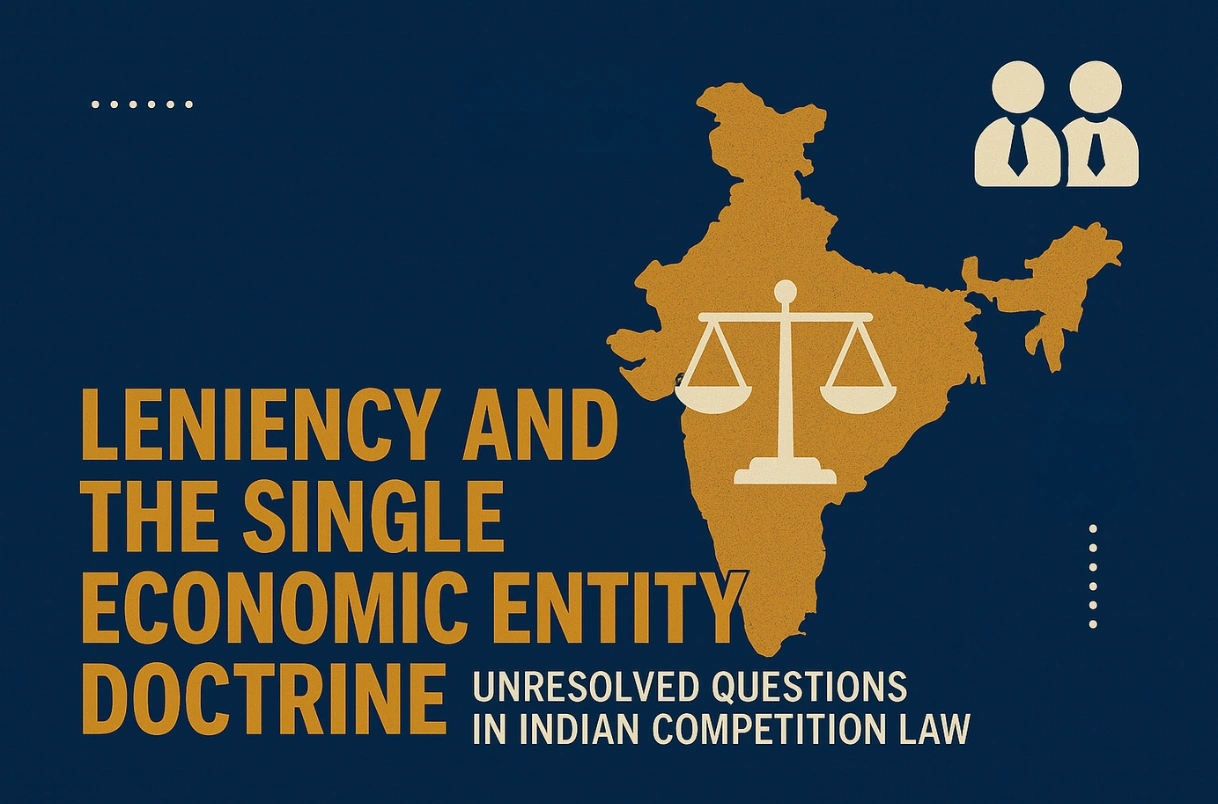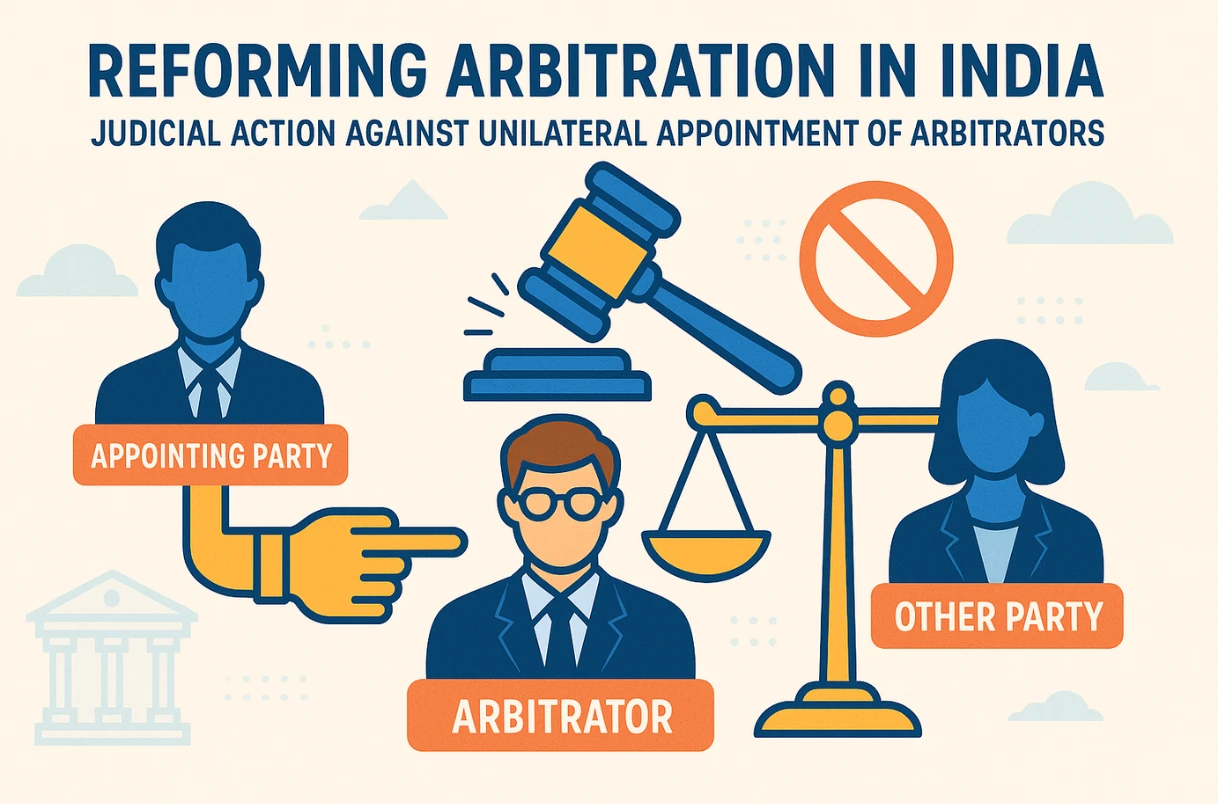Leniency and the Single Economic Entity Doctrine: Unresolved Questions in Indian Competition Law

By – Aditya Pratap Singh
Table of Contents
The Indian leniency framework is anchored in Section 46 of the Competition Act, 2002 (“the Act”), which empowers the Competition Commission of India (“CCI”) to impose a lesser penalty on cartel participants who voluntarily provide “full, true and vital” disclosures about the existence of a cartel. While cartels are prohibited agreements under Sections 2(c) and 3 of the Act, Section 46 recognises the inherent difficulty in detecting secretive collusion and therefore creates a mechanism that rewards insiders who help expose them. In this sense, leniency is not about determining liability that remains established under Section 3 of the Act but about calibrating the extent of penalty to incentivise cooperation. This makes the leniency regime one of the most powerful tools available to the CCI in cartel enforcement, as it transforms cartel participants into whistleblowers.
The Leniency Regime under Indian Competition Law
The Competition Commission of India (Lesser Penalty) Regulations, 2024 (which replaced the earlier 2009 Regulations) set out the operational framework of this regime. These Regulations broaden the definition of “applicant” to include not just enterprises but also individuals acting on behalf of enterprises, associations of enterprises, or even parties not engaged in identical trade who nonetheless participate in a cartel1. To qualify for relief, an applicant must cease participation in the cartel, provide a vital disclosure that enables the Commission to form a prima facie opinion or significantly strengthen an ongoing investigation, and continue to cooperate fully and expeditiously with the CCI and the Director General. The Regulations also codify the concept of priority status (marker system), under which the first applicant may secure up to 100% reduction in penalty, while subsequent applicants may receive up to 50% or 30% depending on the “significant added value” of their contributions in terms of bringing evidence2. These conditions are reinforced by procedural safeguards, applications can be rejected if disclosures are incomplete or misleading, and the Commission retains discretion to impose further restrictions3.
Introduction of the ‘Lesser Penalty Plus’ Mechanism
One of the most notable additions introduced by the 2024 Regulations to the leniency regime is the introduction of “Lesser Penalty Plus”, under this mechanism, an entity that has already filed a leniency application in respect of one cartel (the “first cartel”) may obtain an additional reduction in penalty up to 30% if it discloses the existence of another, previously undetected cartel (the “second cartel”). In such cases, the applicant may also be eligible for 100% immunity in the newly disclosed cartel, provided the disclosure is full, true, and timely. The Regulations further address issues of confidentiality, withdrawal of applications, and treatment of evidence: while the identity of applicants and the documents submitted are generally kept confidential, the CCI and the Director General may use the evidence even if the applicant withdraws, though admissions themselves remain protected.
Unresolved Issues: The Treatment of Single Economic Entities (SEE)
Despite these advancements, the Indian leniency framework continues to face areas of ambiguity that remain unresolved. One such area is the treatment of Single Economic Entities (“SEE”) within leniency proceedings. Unlike “Lesser Penalty Plus,” which was expressly codified in the 2024 Regulations, the application of the SEE doctrine in the context of leniency remains uncertain, leading to inconsistent outcomes and interpretational difficulties.
The Shipping Lines Case: Examining the Application of the SEE Doctrine in Leniency Proceeding
In its landmark decision in In re: Cartelisation by Shipping Lines4, the CCI imposed penalties on four maritime carriers for colluding in the transport of motor vehicles. The order, delivered on 20.01.2022, drew attention not only for its findings on cartel conduct in a specialised logistics market but also for the important questions it raised about the scope of India’s leniency regime. The central issue was whether a parent company and its subsidiary, which operate together as a single economic unit, should both be entitled to the same leniency benefits when one of them cooperates with the Commission. The answer to this question has significant implications: it determines who receives priority (marker) status, who enjoys the highest reduction in penalty, and whether the leniency programme achieves its objective of encouraging timely, complete, and truthful disclosure.
Arguments on Parent–Subsidiary Relationship and Leniency Benefits
In the Shipping Lines Cartel case, Mitsui O.S.K. Lines Ltd. (“OP-3”) and Nissan Motor Car Carrier Company (“OP-4”) submitted that, being in a parent–subsidiary relationship, they constituted a SEE. On that basis, they claimed that OP-4 should receive the same penalty reduction as OP-3, consistent with OP-3’s priority marker status. The CCI, however, rejected this contention, holding that the concept of “group” or SEE is not applicable to leniency proceedings and that the Competition Act, 2002, does not extend the definition of “group” to such applications.
The CCI’s Approach and Its Conceptual Gaps
The CCI’s reasoning in the Shipping Lines case does not clearly distinguish two different uses of the SEE doctrine: its role in inquiries to determine whether entities together form an economic unit for establishing anti-competitive liability, and its potential role in the leniency context, which concerns the reduction of penalty once liability is (or can be) shown.
Distinguishing Liability Assessment from Penalty Reduction
It is important to note that the provision for leniency under Section 46 of the Competition Act, 2002 and the Lesser Penalty Regulations, 2024 does not determine whether an infringement has occurred. That question whether a cartel exists and which entities are responsible is examined under Section 3 of the Act. The SEE doctrine may be applied at this stage to assess whether a parent company and its subsidiary should be treated as part of the same “enterprise” for purposes of liability. Leniency, by contrast, comes into operation only after such conduct has been prima facie established and is concerned solely with the extent of penalty to be imposed.
Why Consistency Matters: Liability vs Leniency
This distinction is crucial in the SEE context. If a parent and subsidiary are recognised as one enterprise for liability purposes, consistency demands that they also be treated as a single applicant when penalty reductions are considered. Failing to maintain this consistency leads to two practical difficulties:
- Firstly, if a subsidiary that has participated in the cartel alongside its parent company provides full cooperation during the investigation but does not submit a separate leniency application, it may be denied any reduction in penalty by the Commission.
- Secondly, there is unreasonable discrimination in the numerical extent of the reduction in penalty granted to the subsidiary and the parent company even though they form an SEE and there exists unity of economic interest among them. This would mean that their conduct or misconduct is for the benefit of the same unit but the financial burden on their turnover is different as they are subjected to the marker system and given priority according to the sequential order of their separate applications.
The SEE Doctrine in Leniency: Statutory Context and Comparative Insights
The application of SEE doctrine within the framework of leniency in India gives rise to unresolved questions. The statutory and regulatory framework does not contain explicit provisions addressing whether, and if so how, SEE should influence the assessment of penalty reductions under Competition Act Section 46. This matter warrants careful consideration on two levels: first, with reference to the language and scheme of the Competition Act, 2002, read with the CCI (Lesser Penalty) Regulations, 2024; and second, by comparison with decisional practice in the European Union, where the principle of economic unity has been applied in leniency contexts.
Statutory Scope for Recognizing a Single Economic Entity under Indian Law
As per the Competition Act, the benefit of a lesser penalty is available to an “enterprise,” and Section 2(h) defines this term broadly to include not only a company itself but also its units, divisions, subsidiaries, acquisitions, or other forms of holdings. This wide definition reflects an intention to capture the economic reality of business organizations rather than confining the concept to a single legal entity5. The CCI (Lesser Penalty) Regulations, 2024, build upon this statutory framework by defining an “applicant” in Regulation 2(1)(c) as an enterprise within the meaning of Section 2(h) and extending this to cover not only an enterprise but also individuals involved on its behalf in the cartel6. This drafting leaves clear scope for recognizing a parent and its subsidiaries together as part of one applicant where they function as a Single Economic Entity. The terminology and structure of the Act and the 2024 Regulations therefore bear close resemblance to the concept of an “undertaking” under European Union law, which consistently treats the undertaking as encompassing subsidiaries, divisions and other controlled entities within a single economic unit.
Therefore, the question of whether separate or joint applications are required should not arise. The Act, read with the 2024 Regulations, provides adequate scope for recognizing a Single Economic Entity as an “enterprise” for the purposes of leniency. Where a parent company and its subsidiary operate as part of the same economic unit, a single application submitted by either should, in principle, extend to the entire entity. This approach ensures consistency with the statutory framework and avoids unnecessary procedural duplication.
Comparative Perspective: Treatment of Single Economic Entities in EU Leniency Practice
In the Shipping Lines Cartel Case, even though there was substantial evidence that OP-3 and OP-4 together constituted a SEE, the CCI required them to file separate applications and accordingly granted different percentages of penalty reduction to each. This approach contrasts with the established practice in the European Union, where leniency is uniformly extended to the entire economic unit. The General Court in the RWE Case observed that the term “undertaking” has to be construed on the basis of the nature of the economic entity7. Similarly, in the LG Display Case, the Court reiterated that the term “undertaking” refers to the economic entity as it exists at the time of the submission of the application, and that the concept of undertaking used in the leniency notice is identical to the term used in Article 101 TFEU8.
Further, in the Organ Peroxides Commission Case, it was held that when a company provides evidence to seek a reduction in fines, the benefit of that reduction extends to the entire undertaking of which the company is a part9. This means that if one entity within a Single Economic Entity cooperates or makes a vital disclosure, the whole group should be eligible for uniform leniency benefits.
Hence, while international practice acknowledges the relevance of the SEE doctrine in leniency matters, its implementation in the Indian context can be undertaken through the existing statutory framework. The broad definition of “enterprise” under Section 2(h) of the Competition Act, read with the CCI (Lesser Penalty) Regulations, 2024, provides an adequate basis for recognizing a group of entities functioning as a Single Economic Entity. Construing such entities collectively through the “undertaking” route would promote greater consistency and coherence in the application of leniency, while reducing procedural duplication and potential disparities in the treatment of entities forming part of the same economic whole.
Strengthening the Leniency Mechanism for Future Challenges
The approach currently reflected in India, which tends to treat entities within a Single Economic Entity as needing separate leniency applications, raises questions about its ability to address certain complex forms of anti-competitive arrangements. Such situations have increasingly been examined in more mature jurisdictions, including the European Union, where the application of the SEE doctrine has been considered more expansively in leniency contexts. One such situation arises when an entity furthers the objectives of a cartel without being a direct member of it. The Sumal Judgment of the European Court of Justice illustrates this point: the Court observed that a subsidiary can, in some circumstances, be held liable for anti-competitive conduct directed by its parent company10. In such cases, the subsidiary company is not directly a member of the cartel but still carries out the cartel’s directions, because it receives instructions or information from its parent company, which is formally part of the cartel. When authorities begin an investigation into the cartel, the subsidiary itself cannot apply for leniency because it is not officially a member of the cartel. Its only hope is that the parent company files a leniency application and includes the subsidiary within it.
Challenges for Subsidiaries within a Single Economic Entity
However, under the current Indian practice, leniency benefits are generally not extended automatically to all companies within the SEE, such as subsidiaries. This means that even if the subsidiary actively cooperates with the investigation and plays a role in exposing the cartel, it may not get protection or a reduction in penalty on its own. The subsidiary is therefore left in a vulnerable position, entirely dependent on whether the parent’s leniency application covers it.
Conclusion
Adopting best practices from other jurisdictions and undertaking an EU leniency comparison with India is an effective approach to strengthening India’s domestic leniency framework. A notable example comes from France, where the Competition Authority applies the principle that all entities belonging to a “single economic unit” at the time of the leniency application are eligible to benefit from leniency11. Incorporating similar principles into the Indian framework would help establish clarity and consistency in applying the SEE doctrine within leniency proceedings, thereby aligning India’s regime with international standards while enhancing its effectiveness.
FAQs
-
What is leniency under the Competition Act, 2002?
Leniency allows members of a cartel to receive a reduced penalty if they voluntarily disclose full, true, and vital information about the cartel’s existence. It is designed to encourage insiders to cooperate with the Competition Commission of India (CCI) and help uncover secretive collusion.
-
How does Section 46 empower the Competition Commission of India?
Section 46 of the Competition Act, 2002 empowers the CCI to impose a lesser penalty on any participant that provides vital information leading to the detection or investigation of a cartel. It focuses on incentivizing cooperation, while liability itself is determined under Section 3.
-
What are the key features of the CCI (Lesser Penalty) Regulations, 2024?
The 2024 Regulations broaden the scope of “applicant” to include both enterprises and individuals, establish a priority-based (marker) system for penalty reductions, and detail cooperation and disclosure obligations. They also strengthen confidentiality protections and codify procedural safeguards for applicants.
-
What is the “Lesser Penalty Plus” mechanism introduced by CCI?
Under the “Lesser Penalty Plus” mechanism, an enterprise already seeking leniency in one cartel may receive an additional penalty reduction of up to 30% if it discloses another, previously unknown cartel. It may also receive full immunity in the newly reported cartel if the disclosure is complete and timely.
-
What is the Single Economic Entity (SEE) doctrine in competition law?
The SEE doctrine recognizes that a parent company and its subsidiaries operating as one economic unit together form a single enterprise. Their conduct and financial interests are viewed collectively rather than as independent legal entities.
-
How was the SEE doctrine applied in the Shipping Lines cartel case?
In the Shipping Lines Cartel case, Mitsui (the parent) and Nissan (its subsidiary) argued that they formed a Single Economic Entity and sought joint leniency benefits. The CCI rejected this claim, ruling that the SEE concept does not apply to leniency proceedings and that each entity must file a separate application.
-
Can a parent company’s leniency application cover its subsidiary?
In principle, yes – if both operate as part of one economic unit under Section 2(h) of the Competition Act. However, under current CCI practice, each entity must apply separately, often leading to inconsistent outcomes within the same Single Economic Entity.
-
How does India’s leniency approach differ from the EU’s?
In the European Union, leniency applies to the entire “undertaking,” so all entities forming part of one economic unit receive the benefit. In India, by contrast, each group company must submit its own leniency application, even if they belong to the same economic group.
-
Why is recognizing SEE important for effective cartel enforcement?
Recognizing SEE ensures consistency between liability and penalty stages, prevents unequal treatment within a single economic unit, reduces procedural duplication, and encourages coordinated cooperation among related entities—strengthening the overall effectiveness of cartel enforcement.
-
What reforms are needed to strengthen India’s leniency framework?
India should integrate the SEE doctrine into its leniency framework, similar to the EU and French models, so that all entities forming part of a single economic unit can benefit equally from one leniency application. This reform would promote clarity, fairness, and stronger incentives for full cooperation in cartel investigations.
References –
- Section 2 (I)(c) of the Competition Commission of India (Lesser Penalty) Regulations, 2024.
- Section 4 of the Competition Commission of India (Lesser Penalty) Regulations, 2024.
- Section 3 Conditions for Lesser Penalty or Lesser Penalty Plus of the Competition Commission of India (Lesser Penalty) Regulations, 2024.
- CCI, Case No. 10 of 2014, decided 20.01.2022,.
- Section 2(h) of the Competition Act provides that “enterprise means a person or a department of the Government, who or which is, or has been, engaged in any activity, relating to the production, storage, supply, distribution, acquisition or control of articles or goods, or the provision of services, of any kind, or in investment, or in the business of acquiring, holding, underwriting or dealing with shares, debentures or other securities of any other body corporate, either directly or through one or more of its units or divisions or subsidiaries, whether such unit or division or subsidiary is located at the same place where the enterprise is located or at a different place or at different places, but does not include any activity of the Government relatable to the sovereign functions of the Government including all activities carried on by the departments of the Central Government dealing with atomic energy, currency, defence and space.”
- Section 2(1)(c) of the CCI Lesser Penalty Regulations 2024 provides that “applicant means an enterprise, as defined in clause (h) of section 2 of the Act, who is or was a member of a cartel and includes an individual who has been involved in the cartel on behalf of an enterprise; and further includes an enterprise or association of enterprises or a person or association of persons, though not engaged in identical or similar trade if it participates or intends to participate in furtherance of such cartel and submits an application for lesser penalty and/or lesser penalty plus to the Commission;
- RWE AG and RWE Dea AG Vs European Commission, Case T-543/08, Judgement of the General Court (Third Chamber) dated 11.07.2014.
- LG Display Co. Ltd and LG Display Taiwan Co. Ltd Vs European Commission, Case T-128/11, Judgement of the General Court (Sixth Chamber) dated 27.02.2014.
- Commission Decision dated 10.12.2003 relating to a proceeding under Article 81 of the EC Treaty and Article 53 of the EEA Agreement (Case COMP/E-2/37.857 — Organic peroxides).
- Judgment of the Court (Grand Chamber) of 6 October 2021. Sumal, S.L. v Mercedes Benz Trucks España, S.L, Case C-882/19.
- Articles L.464-2 IV and R.464-5 of the French Commercial Code.


